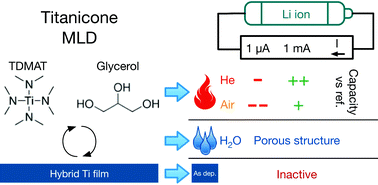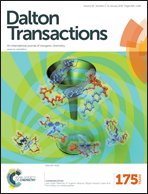Molecular layer deposition of “titanicone”, a titanium-based hybrid material, as an electrode for lithium-ion batteries
Abstract
Molecular layer deposition (MLD) of hybrid organic–inorganic thin films called “titanicones” was achieved using tetrakisdimethylaminotitanium (TDMAT) and glycerol (GL) or ethylene glycol (EG) as precursors. For EG, in situ ellipsometry revealed that the film growth initiates, but terminates after only 5 to 10 cycles, probably because both hydroxyls react with the surface. GL has a third hydroxyl group, and in that case steady state growth could be achieved. The GL process displayed self-limiting reactions for both reactants in the temperature range from 80 °C to 160 °C, with growth rates of 0.9 to 0.2 Å per cycle, respectively. Infrared (FTIR) and X-ray photoelectron spectroscopy (XPS) confirmed the hybrid nature of the films, with a carbon atomic concentration of about 20%. From X-ray reflectivity, the density was estimated at 2.2 g cm−3. A series of films was subjected to water etching and annealing under air or He atmosphere at 500 °C. The carbon content of the films was monitored with FTIR and XPS. Almost all carbon was removed from the air annealed and water treated films. The He annealed samples however retained their carbon content. Ellipsometric porosimetry (EP) showed 20% porosity in the water etched samples, but no porosity in the annealed samples. Electrochemical measurements revealed lithium ion activity during cyclic voltammetry in all treated films, while the as-deposited film was inactive. With increasing charge current, the He annealed samples outperformed amorphous and anatase TiO2 references in terms of capacity retention.


 Please wait while we load your content...
Please wait while we load your content...